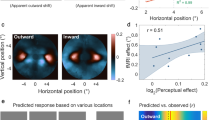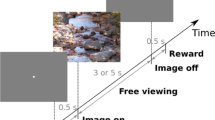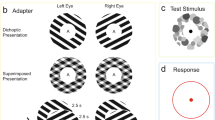Abstract
During binocular rivalry, two incompatible monocular images compete for perceptual dominance, with one pattern temporarily suppressed from conscious awareness. We measured fMRI signals in early visual cortex while subjects viewed rival dichoptic images of two different contrasts; the contrast difference served as a 'tag' for the neuronal representations of the two monocular images. Activity in primary visual cortex (V1) increased when subjects perceived the higher contrast pattern and decreased when subjects perceived the lower contrast pattern. These fluctuations in V1 activity during rivalry were about 55% as large as those evoked by alternately presenting the two monocular images without rivalry. The rivalry-related fluctuations in V1 activity were roughly equal to those observed in other visual areas (V2, V3, V3a and V4v). These results challenge the view that the neuronal mechanisms responsible for binocular rivalry occur primarily in later visual areas.
This is a preview of subscription content, access via your institution
Access options
Subscribe to this journal
Receive 12 print issues and online access
$209.00 per year
only $17.42 per issue
Buy this article
- Purchase on Springer Link
- Instant access to full article PDF
Prices may be subject to local taxes which are calculated during checkout




Similar content being viewed by others
References
Grossberg, S. Cortical dynamics of three-dimensional form, color, and brightness perception: II. Binocular theory. Percept. Psychophys. 41, 117–158 (1987).
Blake, R. A neural theory of binocular rivalry. Psychol. Rev. 96, 145–167 (1989).
Mueller, T. J. physiological model of binocular rivalry. Vis. Neurosci. 4, 63–73 (1990).
Lumer, E. D. A neural model of binocular integration and rivalry based on the coordination of action-potential timing in primary visual cortex. Cereb. Cortex 8, 553–561 ( 1998).
Logothetis, N. K. & Schall, J. D. Neuronal correlates of subjective visual perception. Science 245, 761–763 (1989).
Leopold, D. A. & Logothetis, N. K. Activity changes in early visual cortex reflect monkeys' percepts during binocular rivalry. Nature 379, 549–553 ( 1996).
Leopold, D. A. Brain Mechanisms of Visual Awareness, Thesis, Baylor College of Medicine, (1997).
Sheinberg, D. L. & Logothetis, N. K. The role of temporal cortical areas in perceptual organization. Proc. Natl. Acad. Sci. USA 94, 3408–3413 (1997).
Logothetis, N. K. Single units and conscious vision. Phil. Trans. R. Soc. Lond. B Biol. Sci. 353, 1801–1818 (1998).
Sengpiel, F. & Blakemore, C. Interocular control of neuronal responsiveness in cat visual cortex. Nature 368, 847–850 (1994).
Sengpiel, F., Blakemore, C. & Harrad, R. Interocular suppression in the primary visual cortex: a possible neural basis of binocular rivalry. Vision Res. 35, 179–195 (1995).
Sengpiel, F. Binocular rivalry: ambiguities resolved. Curr. Biol. 7, 447–450 (1997).
Fries, P., Roelfsema, P. R., Engel, A. K., Konig, P. & Singer, W. Synchronization of oscillatory responses in visual cortex correlates with perception in interocular rivalry. Proc. Natl. Acad. Sci. USA 94, 12699– 12704 (1997).
Engel, A. K., Fries, P., Konig, P., Brecht, M. & Singer, W. Temporal binding, binocular rivalry, and consciousness . Conscious. Cogn. 8, 128– 151 (1999).
Brown, R. J. & Norcia, A. M. A method for investigating binocular rivalry in real-time with the steady-state VEP. Vision Res. 37, 2401–2408 (1997).
Tononi, G., Srinivasan, R., Russell, D. P. & Edelman, G. M. Investigating neural correlates of conscious perception by frequency-tagged neuromagnetic responses. Proc. Natl. Acad. Sci. USA 95, 3198–3203 (1998).
Srinivasan, R., Russell, D. P., Edelman, G. M. & Tononi, G. Increased synchronization of neuromagnetic responses during conscious perception . J. Neurosci. 19, 5435– 5448 (1999).
Valle-Inclan, F., Hackley, S. A., de Labra, C. & Alvarez, A. Early visual processing during binocular rivalry studied with visual evoked potentials. Neuroreport 10, 21– 25 (1999).
Tong, F., Nakayama, K., Vaughan, J. T. & Kanwisher, N. Binocular-rivalry and visual awareness in human extrastriate cortex. Neuron 21, 761–773 ( 1998).
Lumer, E. D., Friston, K. J. & Rees, G. Neural correlates of perceptual rivalry in the human brain. Science 280, 1930– 1934 (1998).
Lumer, E. D. & Rees, G. Covariation of activity in visual and prefrontal cortex associated with subjective visual perception. Proc. Natl. Acad. Sci. USA 96, 1669– 1673 (1999).
Heeger, D. J., Huk, A. C., Geisler, W. S. & Albrecht, D. G. Spikes versus BOLD: what does neuroimaging tell us about neuronal activity? Nat. Neurosci. 3, 631– 633 (2000).
Blake, R., O'Shea, R. P. & Mueller, T. J. Spatial zones of binocular rivalry in central and peripheral vision. Vis. Neurosci. 8, 469 –478 (1992).
O'Shea, R. P., Blake, R. & Wolfe, J. M. Binocular rivalry and fusion under scotopic luminances . Perception 23, 771–784 (1994).
Logothetis, N. K., Leopold, D. A. & Sheinberg, D. L. What is rivalling during binocular rivalry? Nature 380, 621–624 ( 1996).
Lee, S. H. & Blake, R. Rival ideas about binocular rivalry . Vision Res. 39, 1447– 1454 (1999).
Yu, K. & Blake, R. Do recognizable figures enjoy an advantage in binocular rivalry? J. Exp. Psychol. Hum. Percept. Perform. 18, 1158–1173 (1992).
Kovacs, I., Papathomas, T. V., Yang, M. & Feher, A. When the brain changes its mind: interocular grouping during binocular rivalry . Proc. Natl. Acad. Sci. USA 93, 15508– 15511 (1996).
Alais, D. & Blake, R. Interactions between global motion and local binocular rivalry. Vision Res. 38, 637–644 (1998).
Blake, R. & Camisa, J. On the inhibitory nature of binocular rivalry suppression. J. Exp. Psychol. Hum. Percept. 5, 315–323 (1979).
Smith, E. L., Levi, D. M., Harwerth, R. S. & White, J. M. Color vision is altered during the suppression phase of binocular rivalry . Science 218, 802–804 (1982).
O'Shea, R. P. Chronometric analysis supports fusion rather than suppression theory of binocular vision. Vision Res. 27, 781– 791 (1987).
Blake, R. & Fox, R. Adaptation to invisible gratings and the site of binocular rivalry suppression. Nature 249 , 488–490 (1974).
Lehmkuhle, S. W. & Fox, R. Effect of binocular rivalry suppression on the motion aftereffect. Vision Res. 15, 855–859 (1975).
Wade, N. J. & Wenderoth, P. The influence of colour and contour rivalry on the magnitude of the tilt after-effect. Vision Res. 18, 827–835 ( 1978).
Blake, R. & Overton, R. The site of binocular rivalry suppression . Perception 8, 143–152 (1979).
O'Shea, R. P. & Crassini, B. Interocular transfer of the motion after-effect is not reduced by binocular rivalry. Vision Res. 21, 801–804 (1981).
Andrews, T. J. & Blakemore, C. Form and motion have independent access to consciousness. Nat. Neurosci. 2, 405–406 (1999).
Wiesenfelder, H. & Blake, R. Apparent motion can survive binocular rivalry suppression. Vision Res. 31, 1589–1599 (1991).
Ress, D., Backus, B. T. & Heeger, D. J. Activity in primary visual cortex predicts performance in a visual detection task. Nat. Neurosci. 3, 940–945 (2000).
Preuss, T. M., Qi, H. & Kaas, J. H. Distinctive compartmental organization of human primary visual cortex. Proc. Natl. Acad. Sci. USA 96, 11601– 11606 (1999).
Rees, G., Friston, K. & Koch, C. A direct quantitative relationship between the functional properties of human and macaque V5. Nat. Neurosci. 3, 716–723 (2000).
Glover, G. H. Simple analytic spiral K-space algorithm. Magn. Reson. Med. 42, 412–415 (1999).
Nestares, O. & Heeger, D. J. Robust multiresolution alignment of MRI brain volumes. Magn. Reson. Med. 43, 705–715 (2000).
Smith, A. et al. Investigation of low frequency drift in fMRI signal. Neuroimage 9, 526–533 ( 1999).
Aguirre, G., Zarahn, E. & D'Esposito, M. The variability of human, bold hemodynamic-responses . Neuroimage 8, 360–369 (1998).
Engel, S. A., Glover, G. H. & Wandell, B. A. Retinotopic organization in human visual cortex and the spatial precision of functional MRI. Cereb. Cortex 7, 181–192 (1997).
Teo, P. C., Sapiro, G. & Wandell, B. A. Creating connected representations of cortical gray matter for functional MRI visualization. IEEE Trans. Med. Imaging 16, 852–863 ( 1997).
Wandell, B., Chial, S. and Backus, B. Visualization and measurement of the cortical surface. J. Cogn. Neurosci. (in press).
Acknowledgements
This research was supported by a grant from the National Eye Institute (R01-EY12741), a NIH Biophysics Training Grant (2T32GM08294), the Vanderbilt Discovery Program and the NSF Center for Neuromorphic Engineering at Caltech. Thanks to G.H. Glover (supported by a NIH National Center for Research Resources grant) for technical support, to D. Leopold for providing us with the single-cell electrophysiological data from his thesis, to N. Logothetis for comments, and to A. Parker and A. Huk for help and advice.
Author information
Authors and Affiliations
Corresponding author
Rights and permissions
About this article
Cite this article
Polonsky, A., Blake, R., Braun, J. et al. Neuronal activity in human primary visual cortex correlates with perception during binocular rivalry. Nat Neurosci 3, 1153–1159 (2000). https://doi.org/10.1038/80676
Received:
Accepted:
Issue Date:
DOI: https://doi.org/10.1038/80676
This article is cited by
-
Tactile information affects alternating visual percepts during binocular rivalry using naturalistic objects
Cognitive Research: Principles and Implications (2022)
-
Methods to assess binocular rivalry with periodic stimuli
The Journal of Mathematical Neuroscience (2020)
-
A hierarchical model of perceptual multistability involving interocular grouping
Journal of Computational Neuroscience (2020)
-
Ring models of binocular rivalry and fusion
Journal of Computational Neuroscience (2020)
-
Altering brain dynamics with transcranial random noise stimulation
Scientific Reports (2019)



